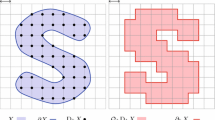Summary
The discrete Laplace–Beltrami operator plays a prominent role in many digital geometry processing applications ranging from denoising to parameterization, editing, and physical simulation. The standard discretization uses the cotangents of the angles in the immersed mesh which leads to a variety of numerical problems. We advocate the use of the intrinsic Laplace–Beltrami operator. It satisfies a local maximum principle, guaranteeing, e.g., that no flipped triangles can occur in parameterizations. It also leads to better conditioned linear systems. The intrinsic Laplace–Beltrami operator is based on an intrinsic Delaunay triangulation of the surface. We detail an incremental algorithm to construct such triangulations together with an overlay structure which captures the relationship between the extrinsic and intrinsic triangulations. Using a variety of example meshes we demonstrate the numerical benefits of the intrinsic Laplace–Beltrami operator.
Similar content being viewed by others
Explore related subjects
Discover the latest articles, news and stories from top researchers in related subjects.References
Bobenko, A. I., Springborn, B. A.: A discrete Laplace–Beltrami operator for simplicial surfaces. Discrete Comput Geometry (2007); DOI 10.1007/s00454-007-9006-1
Botsch M. and Kobbelt L. (2004). An intuitive framework for real-time freeform modeling. ACM Trans Graph 23(3): 630–634
Desbrun, M., Meyer, M., Schröder, P., Barr, A.: Implicit fairing of irregular meshes using diffusion and curvature flow. In: Comp. Graphics (Proc. of SIGGRAPH), pp. 317–324 (1999)
Desbrun M., Meyer M. and Alliez P. (2002). Intrinsic parameterizations of surface meshes. Comp Graph Forum (Proc EG) 21(3): 209–218
Grinspun, E., Hirani, A., Desbrun, M., Schröder, P.: Discrete shells. In: Symp. on Comp. Anim., pp. 62–67 (2003)
Grinspun, E., Schröder, P., Desbrun, M. (eds.): Discrete differential geometry. Course Notes. ACM SIGGRAPH (2005)
Gu, X., Yau, S.-T.: Global conformal surface parameterization. In: Symp. on Geom. Proc., pp. 127–137 (2003)
Indermitte C., Liebling T.M., Troyanov M. and Clémençon H. (2001). Voronoi diagrams on piecewise flat surfaces and an application to biological growth. Theor Comput Sci 263: 263–274
Kharevych L., Springborn B. and Schröder P. (2006). Discrete conformal mappings via circle patterns. ACM Trans Graph 25(2): 412–438
Lévy B., Petitjean S., Ray N. and Maillot J. (2002). Least squares conformal maps for automatic texture atlas generation. ACM Trans Graph 21(3): 362–371
Mercat C. (2001). Discrete Riemann surfaces and the Ising model. Comm Math Phys 218(1): 177–216
Pinkall U. and Polthier K. (1993). Computing discrete minimal surfaces and their conjugates. Experiment Math 2(1): 15–36
Polthier K. and Schmies M. (2002). Straightest geodesics on polyhedral surfaces. In: Hege, H.C. and Polthier, K. (eds) Mathematical visualization, pp 135–152. Springer, Wien New York
Rippa S. (1990). Minimal roughness property of the Delaunay triangulation. CAGD 7(6): 489–497
Shewchuk, J.: What is a good linear element? Interpolation, conditioning, and quality measures. In: Proc. Int. Meshing Roundtable, pp. 115–126 (2002)
Author information
Authors and Affiliations
Corresponding author
Rights and permissions
About this article
Cite this article
Fisher, M., Springborn, B., Schröder, P. et al. An algorithm for the construction of intrinsic delaunay triangulations with applications to digital geometry processing. Computing 81, 199–213 (2007). https://doi.org/10.1007/s00607-007-0249-8
Received:
Accepted:
Published:
Issue Date:
DOI: https://doi.org/10.1007/s00607-007-0249-8




